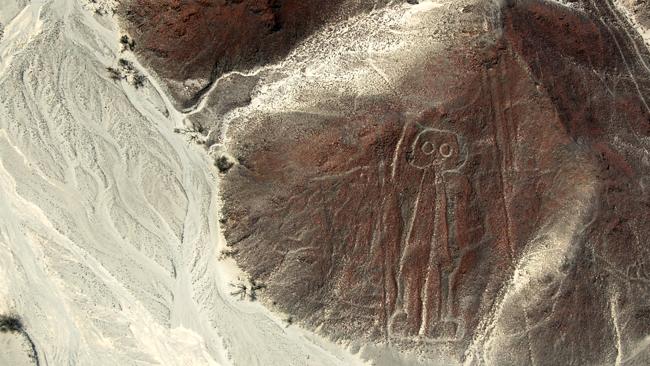The mysterious patterns in the middle of the Nazca desert
HUGE, mysterious markings can be found all over this desert. It’s believed they were created during AD 400, but to this day nobody knows how, or why ...

ETCHED into the land at the Nazca Desert are vast figures of humans, creatures and plants, spread over 1000 square kilometres. Their creation remains somewhat of a mystery.
Lonely Planet ventured to the desert and detailed its perplexing sights in the book The World’s Great Wonders. Here’s what they found. The drone of the propeller blades is deafening. The small plane is being gently buffeted around by the winds. Below lies the vast, red-brown expanse of the Nazca Desert, crisscrossed with snaking ravines. A yell pierces through the din of the propeller. From the copilot’s seat your guide is pointing excitedly at something up ahead. Craning to see through the cockpit windscreen, you catch a glimpse of some lines on the arid plain below. As you get closer, the form of an animal gradually reveals itself — a fanged spider. As the plane circles around for a better view, you shake your head in admiration, marvelling at the incredible perfection of the figure, whose straight lines and precise geometry were created many centuries before satellite and GPS technology was even dreamed of. The spider marking. Picture: Bluelemur The riddle of the sands When commercial flights first started soaring over the Nazca Desert in the 1930s, the barren landscape took on a whole new life. Travellers were astounded to discover vast figures etched into the plains. Of course, locals had known all along of the existence of these ‘ geoglyphs’. Scattered across the huge Nazca plains are over 800 straight lines, 300 geometric figures such as giant trapezoids, and 70 biomorphs of plant and animal designs, including a killer whale, a monkey, a spider and different types of birds. Each giant pattern is created from a single continuous line. So how were they created? Nazca lines of spider leg at sunrise. Picture: Science Photo Library, Getty Images Etching the geoglyph s The desert is made of a surface layer of red-brown pebbles, with a lighter-coloured soil beneath. Scraping away 30 centimetre-deep strips of the darker pebbles exposes paler lines, a bit like a pattern produced in an etching. Scholars have discovered wooden stakes at the ends of some of the lines, suggesting simple surveying techniques were used to create the well-proportioned, geometrical shapes. Research has shown that just a small team of people can recreate some of the largest geoglyphs in a matter of days — without aerial assistance. A more intriguing question is, why were the geoglyphs were created? Hundreds of lines. Picture: Unukorno The purpose of the patterns All sorts of theories as to the function of the geoglyphs have been bandied around over the years: Incan irrigation systems, astronomical observatories, reflections of celestial constellations. One theory suggested the lines were landing strips for alien aircraft! But other archaeological discoveries and scientific evidence have thrown light on another theory. A monkey. Picture: Leander.Canaris The geoglyphs are believed to have been created between AD 400 and 650. Scientists have discovered evidence of a severe, 40-year drought around AD 550—600. With wars over water breaking out, perhaps the geoglyphs were carved into the desert in a desperate bid for help from the gods. The lines may have been for ‘prayer walking’ to worship deities linked with water and fertility. No one knows for sure, though. The geoglyphs could have been created for any number of reasons. The true purpose of the patterns continues to baffle scholars, and the answer remains a mystery. Scene from TV program 'Secrets of Nazca'. The Nazca Lines are huge geoglyphs. Getting there The best way to see the Nazca Lines is from the air. Planes en route to Nazca normally fly over the lines; Aero Condor Perú offers overflight tour packages departing from Ica and Lima. If your wallet won’t stretch that far, Nazca is a major destination for buses on the Pan-American Hwy, and easy to get to from Lima, Ica or Arequipa. Avoid overnight trips, as hijackings are common. Book a tour at your hotel with an official agency. Markings of a bird. Picture: Bluelemur While you’re here Peru is packed with world-renowned sights. Hike the Inca Trail to the famous ancient citadel of Machu Picchu, hop on a reed boat to savour the splendour of Lake Titicaca, one of the highest lakes on the planet, and watch condors glide at one of the world’s deepest canyons, Colca Canyon. Lake Titicaca. Facts and statistics • Some of the Nazca Lines run for up to 50km, while some figures reach up to 200m in length. • The Nazca Lines have survived the centuries due to the conditions in the region: little wind, less than 25mm of rain annually, and a relatively constant temperature of around 25C. This is an extract from The World’s Great Wonders by Jheni Osman © Lonely Planet 2014. In stores now, RRP: $34.99 Lonely Planet’s book The World’s Great Wonders.



